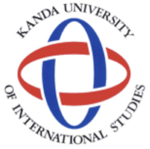Kanda University of International Studies facts for kids
|
神田外語大学
Kanda Gaigo Daigaku |
|
 |
|
| Type | Private |
|---|---|
| Established | 1987 |
| Undergraduates | 3,682 |
| Postgraduates | 30 |
| Location |
Mihama-ku, Chiba
,
,
|
Kanda University of International Studies (神田外語大学, Kanda Gaigo Daigaku), also known as KUIS, is a private university in Japan. It is located in Makuhari, a part of Mihama-ku, Chiba. The university started in 1987. It grew from the Kanda Institute of Foreign Languages in Tokyo. The Sano Educational Foundation runs KUIS. This university is known for its focus on international studies. It is also a top place for learning about how students can take charge of their own learning.
In 2011, about 3,682 students were studying for their first degree. In 2006, 30 students were working on advanced degrees.
Contents
What KUIS Teaches
KUIS has six main areas of study, called departments. The biggest department is English. Other departments include Chinese, Spanish, and Korean. There are also departments for International Communication and Languages and Culture.
The English Department has a special part called the English Language Institute (ELI). In 2006, over 60 teachers from English-speaking countries worked there. They helped students learn English.
Advanced Studies in Language
The Graduate School of Language Sciences began in 1992. This is where students can study for higher degrees. They can learn about teaching English to speakers of other languages (TESOL). They also study Linguistics, which is the science of language. Other topics include how to teach Japanese or English. Students can also study English Communication. In 1996, the Japanese Ministry of Education recognized this school as a "Center of Excellence." This means it was a top place for research. The Center for Language Sciences (CLS) was set up in 2001. It continues this important research.
Learning Different Languages
Students who study International Communication learn English. They also learn about how people communicate and use computers. Students in Languages and Culture also study English. They then pick another language to focus on. These languages can be Spanish, Indonesian, Thai, Vietnamese, or Portuguese.
Japanese Language Program
The Japanese Language and Culture Program started in 2000. This program helps students from other countries. It gives them strong training in Japanese. It also teaches them about Japanese culture, books, and society. In 2006, more than 180 international students were in this program.
Learning on Your Own
The Self-Access Learning Center (SALC) opened in 2001. This center helps students learn languages by themselves. It has 12 advisors from all over the world. These advisors are experts in helping students take charge of their own learning. They talk with students one-on-one.
The SALC offers many things to help students. It has special places and materials for learning. It also holds events and activities. There are courses on how to learn languages well. Students can get advice and support from other students. They can also find chances to be leaders and help others.


